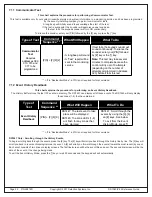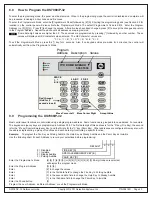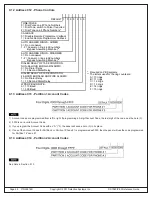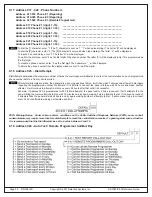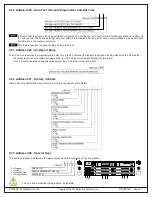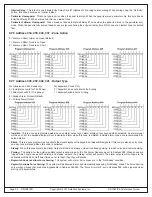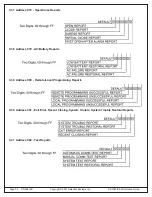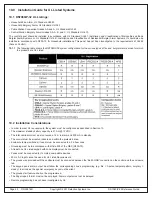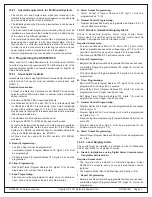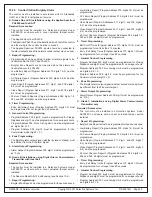
DS7080iP-32 Reference Guide Copyright © 2001 Detection Systems, Inc. P/N 39818D Page 33
• Entry/Exit Delay #1: A delayed zone is ignored during the programmed times immediately following arming during the exit delay. If the
zone is faulted while the control is armed and not in exit delay then an entry delay cycle will be started, and a continuous entry tone will
be sounded at the keypads. If the control is not disarmed by the end of the entry delay, an alarm will result. There are no keypad tones
during the exit delay unless the feature “Keypad Audible During Exit Delay” is selected. Refer to Section 9.9, Address 009. If an entry
delay is running and another entry delay zone is faulted, the entry delay timer is unaffected and will continue timing from the first entry.
The entry delay time and exit delay time can be set independently.
If a delayed zone remains faulted at the end of an exit delay, the panel will optionally signal an exit error condition. The entry delay will
begin as above, and the alarm output will activate with the pattern selected for that zone. If the control is not disarmed by the end of the
entry delay, an alarm will result, and an exit error report will be sent to the central station (following the alarm report if programmed). The
alarm output will deactivate. If the control is disarmed during the delay period started by the exit error condition, no reports will be sent
to the central station and any outputs on during the exit error will deactivate. The exit error report does not follow the dialer delay option.
• Entry/Exit Delay #2: Works in the same manner as the Entry/Exit Delay #1 zone, except that it uses Entry Delay Time #2.
• Interior Entry/Exit Follower: This is a zone programmed to be ignored during an entry/exit delay and then becomes an interior instant
zone. If this zone is violated while the system is armed and no entry/exit zones have been violated, it will activate an instant alarm. If this
zone is violated after an entry/exit delay zone is violated, it will be ignored for the duration of the entry/exit delay time. This zone is
bypassed when arming only the perimeter.
• Interior Home/Away: This zone becomes an active interior entry/exit follower when the system is armed and an entry/exit delay zone
is violated during the exit delay time.
• Interior Instant: These zones arm and disarm with the panel. They are not active if the panel is armed in the “perimeter only” mode.
They never have entry or exit delays. Violation of this type of zone will cause an intrusion alarm.
• Day Monitor: This is a perimeter instant zone that activates alarm outputs when the system is armed, but only activates the keypad
sounders when the system is disarmed. When the system is disarmed, any violation of this zone will activate the keypad sounders
which will sound continuously until a disarming command is entered. The alarm outputs will not operate. A trouble report (if programmed)
will be sent to the central station.
• Keyswitch Toggle: Each time this zone is closed, it will toggle the armed state of the panel. It has a 300 ms response time. To support
this feature, the keypads will generate a single beep for arm or disarm actions.
In a partitioned system, do not assign common zones if the keyswitch toggle feature will be used. Arming/Disarming from a
keypad by users with access to both partitions will cause the keyswitch partition to toggle between Armed and Disarmed. If
keyswitch operation is desired in a partitioned system, avoiding the use of keypads is recommended.
If “Force Arming for Keyswitch Zones” is enabled (Address 038-041), Keyswitch Toggle will force arm a “Not Ready” zone.
• Keyswitch On/Off: When this zone is closed, it will arm the panel. When it is shunted by an EOL (supervised), the panel will be
disarmed. Opening the zone will not affect the arming state of the control. When this option is selected, keypads can not be used to arm
or disarm the system unless the keyswitch zone is manually bypassed, prior to arming the system, from the keypad. If the keyswitch
zone is bypassed, any keypad can perform all arming and disarming functions.
Only one keyswitch on/off zone is allowed per system. Do not use on partitioned systems. Keypads cannot be used on a
system with the keyswitch on/off feature selected.
If “Force Arming for Keyswitch Zones” is enabled (Address 038-041), Keyswitch On/Off will force arm a “Not Ready” zone.
• Fire Zone with Verification: If a fire zone alarms and it is programmed for verification, the control will interrupt the programmable
output(s) set as a switched power return for 10 seconds. During the 10 second power interruption, and for 15 seconds after power
restoral, it will ignore all zone status on all fire zones (to ignore inrush currents). After fifteen seconds, it will monitor all fire zones for two
minutes. If any fire zone returns to alarm within the two minute window it will create a fire alarm condition. If a fire zone does not go into
alarm within the two minute window it will disregard the initial trip. If another alarm occurs on a fire zone with verification after the two
minutes, it will start the process over. After any fire zone is in alarm, all subsequent fire zones are treated as instant (no verification) until
the next fire reset. This same procedure will be performed when a [SYSTEM RESET] is entered, except that the two minute instant
alarm monitoring period is not observed.
Since alarm and trouble reporting to the central station for fire zones is the same as for burg zones (i.e. it is based on the state of the
zone) it is possible for Fire and Fire Trouble restoral signals to be transmitted even though the panel may still be displaying these zone
conditions. This is because the displays are latched until cleared by an operator action.
The use of the controls fire alarm verification feature may not be permitted in some areas. Check your local fire/building codes.
• Fire Zone without Verification: This zone is active and will alarm all 24 hours of the day regardless of the arming state of the control.
An alarm on a fire zone will be silenced by entering a disarm code whether the control is armed or not. If the fire zone restores and
alarms again the alarm will sound again. An open during the armed or disarmed period will send a trouble report and not an alarm. Fire
zones are never silent, invisible, or swinger shunted. All fire zones that have alarmed will continue to show on all keypads until a fire
reset is performed, even if they have physically restored. Fire zones may not be manually bypassed or force bypassed.
If force arming is enabled (see Programming Address 002), force arming is possible when the fire zone is violated (shorted).




